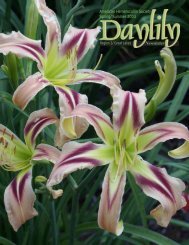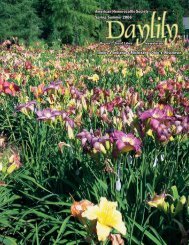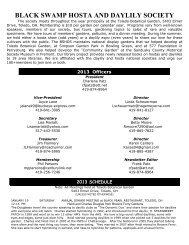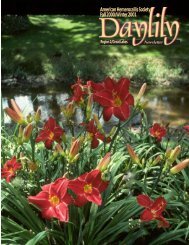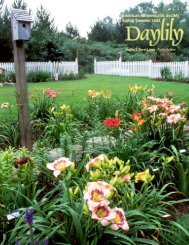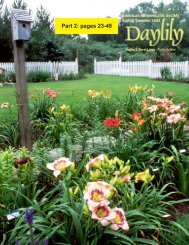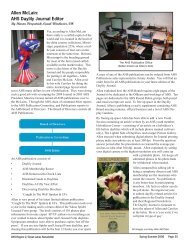Local Club NewsBlack Swamp Hosta andDaylily SocietyBy Charlene Patz2005 marks the 10 th anniversary of thefounding of the Black Swamp Hosta andDaylily Society, and we have another busyfun filled schedule this year. All of ourmeetings are held in the Terrace Room ofthe Conference Center at Toledo BotanicalGarden unless a different venue is listedon our schedule of events.In January we had our annual dinner meeting with GeorgePapadelis from Telly’s Greenhouse and Garden Center as our guestspeaker. We enjoyed George’s amusing commentary and slides ofnew perennials that will be available this year. In February, AmyStone, Extension Agent for Lucas County, had a very informativeprogram on the Emerald Ash Borer infestation in Ohio and Michigan.In March Doug Beilstein from Mansfield spoke on sempervivum,and building and using a hoop house for starting hostas. Thisspring we’ll continue the Tissue Culture program to help educateour members on how to grow hosta tc plants. In May we hold ourannual Perennial Plant Sale at Farmer Jack’s in Perrysburg. This isour only fund raiser to support our philanthropic projects at ToledoBotanical Garden, 577 Foundation, Stranahan Arboretum, and theLibrary project. On Saturday, June 4 th , we are having an accreditedHosta Show with Jim Baumann serving as Show Chairman. Inaddition to the show, a hosta dividing clinic will be given as well astours of Toledo Botanical Garden’s National Hosta Display Garden.With both the national hosta convention and the nationalhemerocallis convention being held in Ohio this year, our membershave the opportunity to attend one or both. Due to a very busysummer schedule this year, for our annual bus trip, we visited theCincinnati Flower Show the end of April.Our annual members garden tour and picnic will be held in July,and we’ll be visiting gardens in Waterville, Whitehouse and BowlingGreen this year. In August we’ll have our annual daylily auction,and continue our Daylily Host program. In September we will bemeeting at Select Stone for a program on using stone andlandscaping in your landscape by Deb Fry. Our guest speaker inOctober will be Clarence Owens from Jackson, MI., and our annualpotluck celebrating our 10 th anniversary will be held in November.Membership is $10 per garden per year expiring December 31st.If you have any questions or are interested in joining the BlackSwamp Hosta and Daylily Society, feel free to contact CharlenePatz, President, Email or Phil Parsons,Membership, Email , for a membershipapplication and the current schedule of events.Officers 2005:Charlene Patz, President ................... Tele: 419-874-8964Vicki Dillon, Vice-President ............... Tele: 419-885-2438Butch (Dennis) Graves, Secretary .... Tele: 419-829-6725Jim Flannery, Treasurer ..................... Tele: 419-874-5995Jerry Vandermermeer, Director .......... Tele: 734-457-4326Joyce Lane, Director ......................... Tele: 419-841-3905Karen Shelt, Director ........................ Tele: 419-843-2527Phil Parsons, Membership ................ Tele: 419-256-7246Frank Patz, Newsletter Editor ........... Tele: 419-874-8964This and That from <strong>AHS</strong> to <strong>Region</strong> 2 NewsThe Wisconsin Daylily SocietyBy John Sheehan2005 has been an exciting one so far for the Wisconsin DaylilySociety. To give our Members hope that spring WILL eventuallycome back to Wisconsin, in spite of the seemingly never-ending,dreary, cold, Wisconsin winter, we have attempted to bring intoMadison speakers with their ever-present carousels containingbrightly colored daylily images.Richard Norris of Ashwood Gardens was scheduled to fly out toMadison in January to describe his exciting daylily hybridizationprogram. We were especially interested in hearing about his new2005 introductions, ASHWOOD RINGS OF SATURN, ASHWOODSMOKEY JOE, and ASHWOOD DARK SIDE. Alas, icy weathercaused the cancellation of his flight. Nancy Nedveck, Club Memberand owner of the Flower Factory, Stoughton, WI., came to ourrescue and talked to our group about new and underused perennialsfor the daylily garden.In February Bob Ellison of Ellison Perennials drove up fromRockford, IL to bring us up-to-date on his daylily hybridizationprogram. Everyone was impressed with Bob’s 2005 daylily Introductions—22new diploid and tetraploid plants that would brightenup any daylily bed AND be hardy in Wisconsin.In March, Jim Murphy flew out from Woodhenge Gardens ofNorth Garden, Virginia to talk to our Members about his spider andspider-like daylilies. Of his 2004-2005 Introductions, I especiallyliked MARGO REED INDEED, THANK YOU, MR. WIZARD, andDROOPY DRAWERS. We all appreciated that Jim has had suchgood luck growing beautiful, healthy, daylilies in the mountains ofVirginia in spite of the freeze and thaw cycles that challenge hisplants every winter.In April, Harlan Hamernik, owner of the Bluebird Nursery, Inc.,Clarkson, Nebraska, will travel to Madison to address a joint meetingof the WDS and the Madison Area Master Gardeners Association.Harlan has a huge inventory of wholesale plants and annuallyships millions of perennials, herbs, grasses and wildflowers all overthe world. He will discuss his experiences propagating plants fromseeds, cuttings, layers, divisions, and tissue culture.Finally, in May, Don Jerabek will fly out from Indianapolis, Indianato describe to us the hybridization program that he and hispartner, Greg McMullen, have developed at Watson Park Daylilies.Images at their website suggest that DANCING ON A STRING,RIPPLE EFFECT, and REGINA MARIE will be big sellers. Theirbeautiful introductions reflect Don’s and Greg’s interest in a widerange of daylily forms and colors.Club Presidents — Club Contacts• Interesting Activities and Happenings♦ Please send your club information in story format to youreditor for inclusion on the Local Club News pages.♦ Deadlines are March 1 for the Spring-Summer issue andSeptember 1 for the Fall-Winter issue.• Officers Change, Address Change, Area Code Change♦ Please notify your RPD, RVP and Editor about change ofOfficers, telephone numbers, area-codes.♦ Notify <strong>AHS</strong> Executive Secretary about any address change.Page 40 Spring-Summer 2005 <strong>AHS</strong> <strong>Region</strong> 2/Great Lakes Newsletter
This and That from <strong>AHS</strong> to <strong>Region</strong> 2The <strong>Region</strong> 2 Hybridizers CornerDown Memory Lane in <strong>Region</strong> 2The Birth of the Chicagoland Daylily SocietyContributed by Bill VaughnReprinted from the Chicagoland Newsletterof November-December 2004.he germ that sparked the beginning of the ChicagolandDaylily Society (CDS) began in 1958 or 1959, whenTHubert Fischer came back from an <strong>AHS</strong> Fall Board Meeting andannounced that the Board had talked him into Chicago hosting the1961 National Convention. The Board felt that since most of theday’s breeders were in this area, it was long overdue for us to hosta National Convention. We knew absolutely nothing about whatlay ahead of us, but since nearly all the gardens on tour would behybridizer gardens, we later learned just how valuable that was toget us off to a grand Convention.out as we are still going strong, and our favorite flower is now theNo. 1 perennial in the USA.As a footnote, yes, this was where the “war between Dips andTets” got off to a lusty start. Orville Fay stated that within 5 yearsDips would no longer exist as Tets would take over. The early Tetswere far from attractive as most were deformed as to both flowerand scapes, prone to scape splitting, or exploding, and other faults.Dr. Virginia Peck, another pioneer in Tet breeding, called it “Popgoes the scape.” Mr. Fay wanted no part of CDS and stated itwould only be a Dip Society. Tets would not be here if they had notconverted Dips. Today most folks cannot tell the difference betweenthe two flowers, and great breeding strides are still beingmade in each. Both Bob Ellison and Leo Sharp hybrids have a lot tosay about today’s Dips.About Bill VaughnAn Interview with Chicagoland DS’sNewsletter Editor Marilyn GrazianoBill Vaughn (Photo taken in Trudi Temple’s garden.)Digital image provided by Chicagoland’sNewsletter Editor Marilyn GrazianoIn late 1959 the first meetings were held to work out details as tobuses, hotel, insurance, tour gardens, food, etc. Countless meetingswere held from then until the big event. Since there was nolocal society to help fund this major project, Hubert Fischer andElmer Claar opened a convention bank account to cover expenses.Mrs. Ryba took care of the insurance. Many lasting friendshipsgrew out of all these meetings, and before the big event there wasalready talk of forming a local society.The Convention attracted 306 people, from far and wide, whichwas the largest ever at the time — remember <strong>AHS</strong> was not even ateenager. Eight of the ten tour gardens, with the exception of Mrs.Ryba and the Watts garden, were all hybridizer gardens. And yes, itwas a 3-day Convention.In January or February, of 1962, a meeting was held at the homeof the Fischers, in Hinsdale. The following were there to help getCDS birthed and going: Hubert and Marie Fischer, Paul and LouiseWatts, Nate and Thelma Rudolph, Jim and Searcy Marsh, Jim andEsther Coffey, Ed and Emily Varnum, and Bill Vaughn.Mr. Fischer agreed to be the first President as he was on the <strong>AHS</strong>Board of Directors and knew all the workings of the Society. I haveno record as to the other officers, but as you can see, it all worked<strong>AHS</strong> <strong>Region</strong> 2/Great Lakes Newsletterill reminisced, telling of his love of flowers and plantsthat goes way back to his earliest childhood memories.The early years, in the Great Depression, were spent inBCentral Missouri (Boone County), which was rich in many kinds ofwildflowers. In those days there were no deer and the local woodsand hills were real treasure troves, which are rarely seen now.Daffodils were his first outdoor plant love as his grandmotherhad the large doubles (probably Van Scion) in her country yard.Daylily plants were forbidden in the yard because of their spreadinghabit. Once he moved some small plants into a yard and thelandlord fast dug them out and said he could plant his flowersaround the edge of the vegetable garden, but no Daylily plants.The old Lemon Lily was not considered a Daylily by the locals.He ordered his first hybrids from Wilds in 1951 and the dam wasbroken. His first National Convention of <strong>AHS</strong> was in 1961 and hisgarden in Ottawa was filled quickly with new plants. Once his parentsmoved to a 2-acre country place, near Starved Rock, the ordersfrom all the growers increased. His first registration in 1969 wasSPARROW, a soft gold dusted purple, 2-1/2 inch, 28 inch tall MLdormant diploid with a gold throat. TOMMY ({[(LUCRETIUS xCRESTWOOD ANN) x TETRA LUXURY LACE] X FAIR MARGA-RET}, a 24 inch M light gold self dormant tetraploid with 2-1/2 inchflowers and a green throat, registered in 1975 and introduced byHite in 1978, won the Florida Sunshine Cup at the 1981 NationalConvention in Chicago. It also earned the <strong>AHS</strong> HM in 1981. In 1978Walter Jablonski named a daylily WILLIAM VAUGHN (TETRASUDIE X SILVER FROST) for him. Bill registered 15 cultivars. (Seelisting next page.)To Bill, the best part of all of this was knowing, and being friendswith, the Chicago pioneers in Hem breeding: Hubert Fischer, NateRudolph, Brother Charles, and Jim Marsh. Later he became friendswith Pauline Henry and was able to visit her garden at bloom timefrom 1985 until her death in 2000. He selected several of her seed-Continued on page 42Spring-Summer 2005 Page 41



